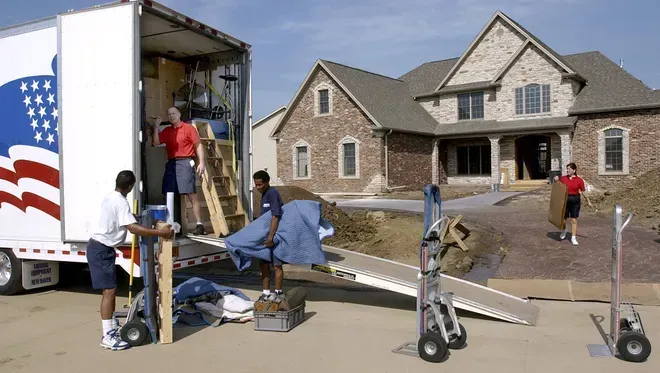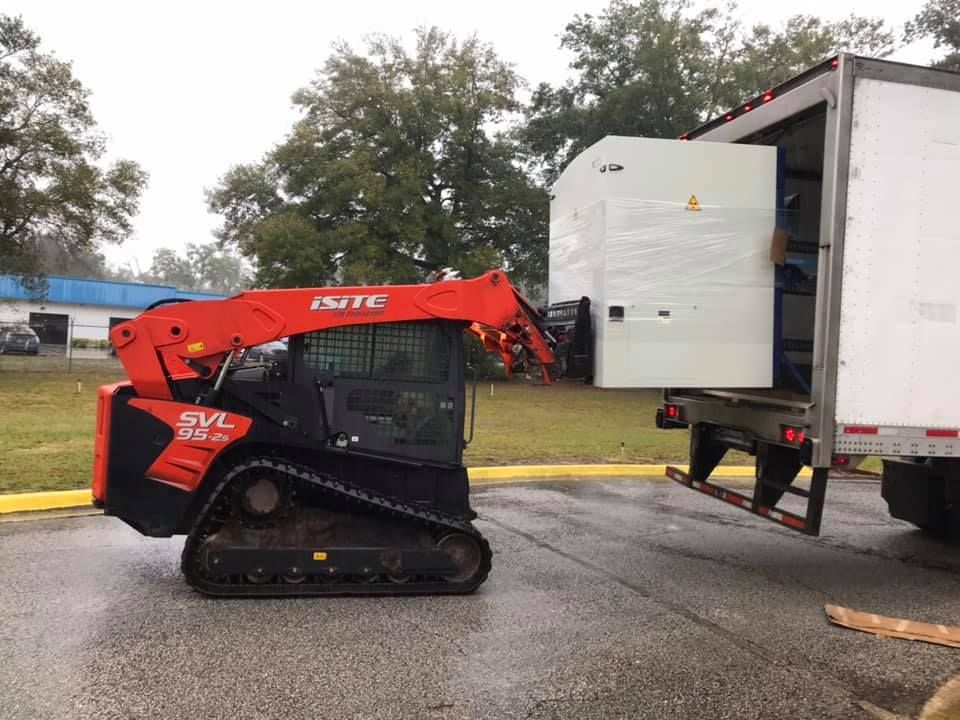BLOG
We Earned Their TRUST...
Now, Let Us Earn Yours!
Decoding the Costs of Business Relocation Services in Orlando, FL

Relocating your business involves meticulous planning, expert packing, secure transportation, and precise reinstallation of all your commercial assets. Grasping the factors that influence these costs is crucial for effective budgeting and selecting the ideal moving partner. This guide dives into the primary cost drivers for commercial moves, uncovers potential hidden fees that can inflate estimates, and offers actionable budgeting steps specifically for the Orlando and Florida markets. You'll learn how elements like office size, travel distance, labor needs, packing choices, specialized equipment, insurance, and timing all play a role in pricing. We'll also show you how to sidestep unexpected expenses while ensuring your business operations remain uninterrupted. After exploring the core cost influences, we'll compare local hourly pricing models with long-distance weight-based strategies, highlight common hidden fees and how to avoid them, and provide a step-by-step budgeting template complete with contingency advice. For businesses seeking local expertise and a clear pricing approach, MOVE IT ALL / Full Service Mover stands out as a transparent provider of Commercial Moving Services, offering complimentary on-site flat-rate estimates for qualifying moves to demonstrate how straightforward pricing can eliminate surprises. The sections that follow will break down each factor, feature comparison tables for quick decision-making, and guide you through requesting a customized estimate that perfectly aligns with your business objectives.
What Are the Key Factors Influencing Commercial Moving Costs?

The cost of commercial moving is shaped by tangible factors such as the volume of items, the distance to be traveled, the labor required, the extent of packing services, the handling of specialized items, insurance selections, and the chosen timing of the move. Each of these elements directly impacts the scope of work and the associated risks. Simply put, a larger volume or greater complexity means more crew hours and equipment usage, leading to higher labor and transportation expenses. Similarly, heavier or regulated items add complexity and potential permitting costs, further increasing the overall quote. Understanding these drivers empowers procurement teams to compare bids effectively, allocate contingency funds wisely, and select service levels that strike the right balance between cost and risk. The following paragraphs detail these primary factors and include a quick-reference table illustrating typical impacts and examples.
The principal cost drivers include:
- Office size and volume: Larger spaces necessitate more movers, packing supplies, and truck capacity.
- Distance and transportation: Longer journeys mean increased mileage, fuel consumption, and potential overnight logistics.
- Labor and crew size: The need for skilled crews and potential overtime significantly impacts total labor expenses.
- Packing services and materials: Opting for full packing services adds labor and material costs, while partial packing can reduce expenses.
- Specialty equipment handling: Medical equipment, IT infrastructure, safes, and machinery require specialized crews, tools, or permits.
- Insurance and valuation: Higher levels of coverage reduce client risk but increase the overall price.
- Timing and scheduling: Moves during peak seasons, weekends, or after business hours often incur surcharges.
These factors often interact—more volume means more labor hours, and specialty items extend crew time—making a precise on-site assessment essential for firm pricing and minimizing estimation discrepancies.
Different factors influence costs in distinct ways; the table below maps these elements to their attributes and typical impacts or qualitative effects for easy comparison.
| Factor | Attribute | Typical Impact / Example |
|---|---|---|
| Office size & volume | Number of workstations and cubic feet | Larger offices demand more crew hours and multiple truckloads; impact ranges from moderate to significant |
| Distance | Local vs. long-distance miles | Local moves typically use hourly rates; long-distance moves add fuel, tolls, and potential lodging expenses |
| Labor requirements | Crew size and skill level | Skilled crews and larger teams increase hourly totals but can shorten overall move duration |
| Packing services | Full vs. partial packing | Full packing adds labor and materials; partial packing reduces labor but shifts some risk to the client |
| Specialty equipment | Weight, permits, disassembly | Heavy machinery, safes, and medical devices require specialized rigging and permits, substantially increasing costs |
How Does Office Size and Volume Affect Moving Expenses?
Office size and volume encompass the square footage, the quantity of desks, storage units, and any other inventory that dictates the required crew hours, truck capacity, and packing materials for a move. A larger volume translates to increased handling time and may necessitate multiple truck trips or larger vehicles, thereby compounding transportation and labor charges. For instance, small offices with just a few desks might only need a two-person crew for a few hours, whereas larger corporate relocations demand multiple teams working concurrently, increasing coordination efforts and the total cost. Estimating volume early is key to determining whether a move qualifies for flat-rate on-site estimates or should be quoted on an hourly basis with a clearly defined crew composition.
A higher volume also increases the likelihood of needing specialized handling—such as for server racks or machinery—which requires additional equipment or third-party contractors. These specialized needs must be explicitly itemized in your budget to prevent unexpected expenses. Accurate inventory lists and pre-move surveys are vital for reducing estimation variance and enabling procurement teams to select the most suitable service package.
How Does the Distance of Your Business Move Impact Pricing?
The distance of your move dictates whether movers charge by the hour for local relocations or use fixed/weight-based models for long-distance moves. It also drives variable costs like fuel, tolls, and driver time. Local moves typically employ hourly rates where crew time combined with truck time constitutes the primary expense. Long-distance moves, on the other hand, are often priced based on truck weight, mileage bands, or flat trip fees that bundle labor and transport. The greater the distance, the more likely the quote will include fuel surcharges, tolls, and potentially overnight lodging for drivers if Hours of Service regulations come into play.
Distance also adds to logistical complexity—longer moves require route planning, potential staging areas, and additional insurance considerations. Businesses should always confirm the pricing model a provider uses and precisely what is included. Obtaining an on-site estimate is invaluable for determining whether a local hourly structure or a long-distance fixed model better suits your organization's tolerance for price variability.
What Role Do Labor Requirements and Crew Size Play in Cost?
Labor requirements and crew size directly translate the physical workload into billable hours, making them one of the most significant cost drivers. A larger or more specialized crew will increase hourly totals but can also shorten the overall timeline. The principle is straightforward: the number of crew members multiplies the per-hour labor rates, and specialized skills—such as rigging, IT disassembly, or certified equipment handling—command premium rates that add to the base labor cost. Businesses must weigh the benefit of faster completion (achieved with a larger crew) against the total labor expense, as a smaller crew working longer hours can sometimes prove more costly due to extended billed hours or overtime.
Clearly defining the scope of work—what needs to be disassembled, packed, or reassembled—prevents cost escalations and helps planners decide whether to engage short-term specialized labor for complex items. Providers that clearly outline crew composition and estimated hours in a formal estimate significantly reduce ambiguity and improve budgeting accuracy.
How Do Packing Services and Materials Influence Your Budget?
Packing services and materials represent a combination of labor and consumables that vary based on the scope of work. Full packing services utilize professional crews and materials to wrap and crate every item. Partial packing services focus on fragile or high-value items, while DIY packing minimizes labor costs but transfers the risk to the client. Full packing increases the upfront cost due to additional crew hours and materials like boxes, bubble wrap, and custom crating, but it significantly reduces the risk of damage and saves valuable internal staff time. Conversely, partial packing offers a hybrid solution where businesses pack general items internally and hire professionals for sensitive equipment, striking a balance between cost and protection.
Understanding the cost-benefit analysis of full versus partial packing is essential. When expensive specialty equipment is involved, professional crating and handling can prevent costly replacement expenses, often justifying the packing premium in a total cost-of-risk assessment.
What Are the Cost Considerations for Handling Specialty Equipment?
Specialty equipment—including IT racks, medical imaging machines, industrial machinery, and safes—requires meticulous planning, specialized rigging, and sometimes third-party specialists or permits, all of which increase both the time and the price. The underlying mechanism is that heavier or more delicate items demand bespoke equipment, disassembly/reassembly, and protective crating. Each of these steps adds crew hours and potentially subcontractor fees. Businesses should meticulously list all specialty items during the initial survey so the estimator can allocate appropriate resources and advise on necessary permits, floor protection, or crane services.
Choosing movers who can coordinate third-party specialists and validate insurance coverage for specialty items significantly reduces operational risk and prevents incremental charges during execution. Clear, upfront documentation of these items is crucial for preventing day-of surprises and ensuring accurate budgeting.
How Does Insurance Coverage Affect Commercial Moving Costs?
Insurance coverage choices—ranging from basic liability to full-value protection—directly impact both the mover’s liability and the price the customer pays. Higher coverage levels reduce the client’s exposure to financial loss but increase the premium or line-item cost. Basic coverage typically reimburses limited per-pound values and shifts the replacement risk to the business, whereas full-value protection insures the declared value of items and may require higher upfront fees or detailed valuation declarations. Organizations with expensive equipment should opt for higher valuation levels and carefully confirm exclusions, loss procedures, and required documentation.
Comparing coverage types and their associated costs during the estimate review process ensures that the budget accurately reflects your true risk tolerance and potential replacement exposure. Moving providers that clearly present coverage options and examples of claim scenarios empower decision-makers to choose the most appropriate protection.
When Does Timing Impact Your Business Relocation Pricing?
Timing influences commercial moving costs through seasonal demand, day-of-week premiums, and after-hours charges. High-demand periods and tight scheduling windows reduce provider flexibility and often necessitate higher rates. The underlying principle is that peak months, month-end lease turnovers, and requests for moves during nights or weekends require crews to work overtime or prioritize jobs, leading to surcharges. Businesses can often reduce costs by scheduling during off-peak windows, implementing phased moves, or providing wider date ranges for providers to optimize routing.
Advance planning and flexible timing can significantly reduce premium exposure and often result in better rates, whereas tight deadlines and last-minute scheduling increase labor intensity and total expense. Negotiating date flexibility into contracts is a practical strategy for capturing savings and reducing logistical pressure.
What Potential Hidden Costs Should Businesses Anticipate During Relocation?

Hidden costs in commercial relocation frequently arise from access challenges, after-hours work, lease obligations, and indirect downtime, and they can substantially inflate the initial moving budget if not anticipated. The mechanism behind these hidden fees is that site-specific conditions—such as stairs, long carries, parking restrictions, or building rules—create additional labor and time that service providers must bill to remain profitable. Proactively identifying potential fees and negotiating transparency in the estimate is key to preventing surprises and enabling better contingency planning. The following table lists typical hidden fees, provides example costs or triggers, and indicates when each might apply, helping procurement teams spot potential risk areas before selecting a mover.
Before diving into the table, consider this brief list of common hidden costs:
- Elevator and long carry fees: Additional charges incurred when movers must hand-carry items over extended distances or navigate stairwells.
- After-hours and weekend surcharges: Premiums applied for moves conducted outside standard business hours or on weekends.
- Permit and parking costs: Expenses related to municipal or building permits and paid parking required for loading/unloading zones.
- Lease termination and setup fees: Non-mover costs such as penalties, cabling installation, and tenant improvement fees.
These hidden items often stem from site access and scheduling constraints; thorough pre-move surveys and close coordination with landlords can significantly reduce their likelihood and help transparently transfer or share costs.
| Access or Fee Type | Trigger / When It Applies | Example Impact / Mitigation |
|---|---|---|
| Elevator / Long carry | Stairs, long distances from truck to entrance | Adds crew hours or requires special equipment; mitigate by staging items and reserving elevator access |
| After-hours surcharge | Work outside normal business hours | Premium hourly rates apply; avoid by scheduling during off-peak times or using phased moves |
| Permits / Parking | Municipal or building requirements | Permit fees or paid parking add direct costs; secure necessary permits early to prevent fines |
| Lease termination / Setup | Early lease exit, new cabling, fit-out requirements | Non-mover expenses that must be budgeted separately; thoroughly review contracts before moving |
How Do Access Challenges Like Elevator and Long Carry Fees Add to Costs?
Access challenges, such as the absence of elevator access, parking limitations, or long carries from the truck to the office, increase labor time and risk, often resulting in explicit fees on a mover's invoice. The mechanism is that every additional minute or extra crew member required to navigate stairs or cover long carries multiplies labor charges and may necessitate protective materials or additional insurance for higher-risk handling. Organizations should provide detailed building layout information and loading dock access during the survey to allow movers to plan staging, elevator reservations, or alternative routing effectively.
Mitigation strategies include securing loading zones in advance, negotiating elevator access windows with building management, pre-staging items near entrances, and clarifying any long-carry fees in the contract to prevent day-of disputes and surprise charges.
What Are After-Hours and Weekend Service Charges?
After-hours and weekend service charges are premium rates applied when moves occur outside standard business hours. These reflect overtime costs for crews, staffing premiums, and potential building access limitations. These surcharges arise because crews working nights or weekends often incur overtime pay or require special scheduling arrangements that reduce the provider's flexibility for other jobs. Companies seeking to minimize costs should consider off-peak weekday moves, phased scheduling, or flexible windows that enable movers to assign resources without incurring overtime.
When night or weekend moves are operationally essential to prevent downtime, businesses should request transparent line items for these surcharges and compare them across multiple bids to select the most cost-effective provider while balancing productivity needs.
How Can Lease Termination and New Setup Fees Affect Your Budget?
Lease termination penalties, new office cabling installation, furniture setup, and tenant improvement fees are non-mover costs that can significantly impact relocation budgets and often fall outside the moving company’s direct scope. The underlying mechanism is that these obligations are contractual or service-provider charges linked to landlord agreements and subcontractor work, and they can potentially outweigh moving fees if not properly planned. Businesses must thoroughly review lease terms early in the process, coordinate landlord responsibilities, and obtain quotes for setup services like IT cabling or fit-outs to include in the total relocation budget.
Incorporating these items as separate line items in the master budget and assigning clear responsibility for payment prevents last-minute funding gaps and clarifies precisely which costs the mover will and will not handle.
What Is the Impact of Business Downtime and Productivity Loss on Overall Costs?
Business downtime and productivity loss represent indirect costs that can potentially exceed direct moving fees. Their magnitude depends heavily on revenue per employee, the extent of critical systems downtime, and the effectiveness of continuity planning. The mechanism driving this cost is lost billing hours, delayed projects, and disruptions to customer service during the move window. Calculating downtime costs requires estimating affected staff hours and multiplying them by the average revenue contribution per employee. Businesses can minimize downtime through phased moves, scheduling critical systems moves after hours, and pre-move IT staging to ensure services are quickly restored.
Quantifying potential downtime and adding it to the relocation budget informs decisions about investing in expedited services or additional crews to shorten the transition time and protect revenue streams.
How Can Businesses Effectively Budget for Office Relocation Expenses?
An effective office relocation budget meticulously lists direct moving costs, indirect business-impact costs, contingency funds, and non-mover expenses, coupled with a disciplined review of estimates against a baseline inventory. The recommended method involves collecting line-item quotes for labor, transportation, packing, specialty handling, insurance, and any known third-party services. Subsequently, add indirect costs such as downtime, setup fees, and a contingency allocation. This structured approach transforms unknowns into quantified risks and facilitates informed trade-offs between cost and speed. The following numbered list provides a stepwise budgeting template that organizations can adapt to their specific move size and complexity.
Follow these steps when building your commercial moving budget:
- Inventory and scope: Develop a detailed asset and furniture inventory to accurately determine volume and identify specialty items.
- Gather line-item quotes: Request written estimates for labor, trucks, packing, specialty handling, and insurance from multiple providers.
- Add indirect costs: Estimate potential downtime, IT reinstallation, cabling, and lease-related charges as separate budget items.
- Set contingency: Allocate 5-10% of total estimated costs to cover unforeseen expenses.
- Compare scenarios: Evaluate the cost and risk trade-offs between phased moves versus single-day relocations.
| Budget Component | Description | Typical Allocation / Note |
|---|---|---|
| Direct moving costs | Labor, trucks, packing, specialty handling | Core line items obtained from mover estimates |
| Indirect costs | Downtime, IT reinstall, tenant improvements | Quantify based on revenue impact and vendor quotes |
| Contingency | Unforeseen fees and scope changes | Recommended 5-10% of combined direct and indirect costs |
| Insurance & valuation | Coverage for goods in transit | Select based on equipment value and risk tolerance |
What Are the Best Practices for Creating a Commercial Moving Budget?
Best practices begin with a comprehensive inventory, early engagement with vendors, and line-item comparisons that clearly distinguish included services from exclusions, thereby preventing misinterpretations of quotes. The underlying principle is to reduce estimation variance by standardizing request-for-proposal details, explicitly asking for written descriptions of exclusions, and verifying specialty handling and permit requirements during an on-site survey. Scheduling milestones, defining stakeholder responsibilities, and establishing communication plans should accompany the budget to effectively coordinate internal teams and external contractors.
As a subsequent step, businesses should ensure contingency funds are readily accessible and revisit vendor quotes whenever timing or scope changes occur to maintain budget accuracy and avoid rushed, potentially costly decisions.
Which Cost-Saving Strategies Can Reduce Business Moving Expenses?
Effective cost-saving strategies include implementing phased moves, scheduling during off-peak times, selective professional packing, redeploying existing furniture, and consolidating vendors to leverage volume discounts. Each of these tactics aims to reduce either labor hours or material costs. The mechanism involves splitting non-critical moves into phases to lessen peak crew demands, scheduling during off-peak times to reduce surcharge exposure, and employing selective packing to balance cost with adequate protection. Negotiation tactics—such as bundling services or requesting itemized reductions—can yield measurable savings.
Applying these strategies requires mapping tasks to internal capabilities and determining where professional services offer the most cost-effective risk reduction, particularly for specialty equipment or mission-critical systems.
How Should Contingency Planning Be Incorporated into Your Moving Budget?
Contingency planning involves setting aside 5-10% of the combined direct and indirect estimated costs to cover unforeseen items such as additional rigging, permit delays, or temporary storage needs. The mechanism is to treat contingency as reserved funds that the project manager can allocate when the scope deviates or unexpected charges arise, thereby preventing budget shortfalls and the need for rushed approvals. Examples of contingency use include last-minute specialty rigging for a machine, expedited couriers for missing components, or temporary staffing to accelerate reinstallation.
Clearly document contingency policies—including who approves fund releases, under what circumstances, and how costs are tracked—to ensure transparent and controlled utilization of these funds.
How Do Local vs. Long-Distance Commercial Moving Costs Differ?
Local and long-distance commercial moving costs diverge in their pricing models, operational drivers, and regulatory considerations. Local moves are typically charged hourly, while long-distance moves are often priced based on weight or fixed trip rates. The mechanism is that local providers bill for crew time and truck hours, which aligns incentives for efficiency. Long-distance pricing, conversely, bundles transport costs and may depend on total shipment weight and distance bands. Regional market dynamics in Orlando and Florida—such as parking availability, permitting requirements, and seasonal demand—further modify local hourly rates or access fees. Therefore, comparing models requires a careful examination of inclusions and assumptions. The table below contrasts pricing models and provides example scenarios to guide your decision-making.
| Pricing Model | Typical Use Case | Example / When It Applies |
|---|---|---|
| Hourly local rates | Short-distance moves within metro areas | Ideal for same-day relocations with predictable crew hours |
| Fixed / weight-based long-distance | Inter-state or long-haul moves | Suitable for cross-region relocations where truck routing and weight determine cost |
| Flat-rate on-site estimates | Large or complex local jobs | Used when volume or complexity warrants a firm flat price, especially for moves exceeding 2,500 sq. ft. |
What Are Typical Hourly Rates for Local Business Moves in Orlando?
Local hourly rates in Orlando reflect a model where businesses pay for crew time, truck usage, and materials. However, exact dollar ranges can vary significantly based on the mover, crew composition, and service inclusions. Because rates differ, businesses should always request itemized hourly estimates and detailed crew breakdowns. The pricing mechanism for local moves is straightforward: the total billed amount equals crew hours multiplied by the hourly rates, plus truck fees and materials. MOVE IT ALL / Full Service Mover utilizes a local hourly pricing structure for many commercial jobs and offers complimentary on-site flat-rate estimates for qualifying businesses exceeding 2,500 square feet to enhance quote certainty. Requesting a written estimate that clearly lists crew size, estimated hours, and materials is crucial for avoiding surprises and enabling apples-to-apples vendor comparisons.
Businesses should confirm what constitutes billable time and whether travel or parking expenses are included to prevent invoice discrepancies.
How Is Fixed or Weight-Based Pricing Applied to Long-Distance Moves?
Fixed or weight-based pricing for long-distance moves consolidates transport logistics into a single quote, often based on estimated shipment weight, distance bands, and predefined inclusions and exclusions. The mechanism involves using weight estimates to determine truck allocation and fuel/toll planning, allowing providers to price the entire move as a single figure, sometimes with additional line items for crating, insurance, or specialty handling. Businesses should carefully verify weight assumptions, inclusions like fuel surcharges, and whether crating or full-value protection is part of the fixed quote.
Comparing fixed quotes requires a thorough review of what is excluded—such as packing labor, third-party rigging, or specific insurance coverages—to ensure accurate, like-for-like assessments.
What Local Factors in Orlando and Florida Influence Moving Costs?
Orlando and Florida-specific factors, including municipal permitting requirements, parking restrictions in high-traffic zones, seasonal peaks tied to tourism or end-of-month lease cycles, and regional labor availability, can significantly impact both scheduling and price. The underlying mechanism is that local regulatory or access burdens increase time spent on-site and necessitate permits, while seasonality and labor supply can drive rates higher during peak periods. Mitigation actions include securing parking permits in advance, coordinating elevator and loading dock windows with property managers, and scheduling moves during lower-demand periods whenever feasible.
Proactive local planning helps reduce permit-related fines and lowers the chance of last-minute scope changes that can drive up costs.
How Does MOVE IT ALL Ensure Transparent and Reliable Commercial Moving Pricing?
MOVE IT ALL / Full Service Mover prioritizes transparency by offering clear estimate practices, eligibility for complimentary on-site flat-rate estimates on qualifying large moves, and detailed service descriptions that clearly delineate included and excluded items. This approach empowers businesses to effectively control budget risk. The core mechanism is that on-site assessments accurately capture volume, specialty equipment, and site access constraints, ensuring quotes reflect the actual scope rather than assumptions. Flat-rate estimates provide price certainty when conditions are well-documented. MOVE IT ALL’s Commercial Moving Services present a range of options—such as full and partial packing, specialized handling for heavy machinery and cubicle relocations, and emergency same-day services—allowing clients to select the combination that best balances cost and operational continuity.
Providing a clear scope of work and a written estimate significantly reduces potential disputes and supports predictable budgeting for business moves.
What Are MOVE IT ALL’s Free On-Site Estimate and Flat Rate Options?
MOVE IT ALL offers complimentary on-site flat-rate estimates for businesses exceeding 2,500 sq. ft. This process involves an on-site survey to meticulously assess asset counts, identify specialty items, understand access constraints, and determine scheduling needs, culminating in a firm proposal. During the estimate visit, MOVE IT ALL evaluates labor requirements, packing scope, transportation needs, and any necessary permits or equipment. Subsequently, they present flat-rate or itemized hourly options based on the collected data. This comprehensive process ensures clients fully understand all inclusions, such as crew composition, packing materials, and specialty handling, thereby minimizing the risk of day-of adjustments that lead to invoice surprises.
Requesting an on-site estimate is a practical and essential step to convert preliminary budget assumptions into a validated, written offer.
How Does MOVE IT ALL Minimize Business Disruption During Moves?
MOVE IT ALL minimizes disruption by expertly coordinating phased moves, offering after-hours work when necessary, staging equipment for rapid reinstallation, and integrating IT relocation planning to reduce downtime for critical systems. The underlying strategy is to allocate resources and timings strategically to keep essential operations running smoothly while moving non-critical assets. This is achieved through the use of experienced crews and planning buffers designed to prevent cascading delays. MOVE IT ALL’s Commercial Moving Services emphasize seamless transitions and minimized disruption as a core value proposition, pairing meticulous logistics planning with execution strategies that actively protect productivity.
Measuring success involves tracking move duration, quantifying downtime hours avoided, and ensuring adherence to agreed-upon timelines, allowing clients to effectively evaluate the return on investment.
How Can Businesses Request a Personalized Commercial Moving Quote?
To request a personalized commercial moving quote from MOVE IT ALL, businesses should prepare an inventory list, identify any specialty items, document site access and parking constraints, and collect their target move dates. Providing facility details, square footage, and any known restrictions enables an accurate on-site assessment and, for qualifying locations, a free flat-rate estimate for moves exceeding 2,500 sq. ft. Expect the estimator to outline crew size, packing options, required permits, and insurance choices, and to deliver a written estimate that clearly identifies inclusions and exclusions for straightforward comparison.
Preparing this information upfront significantly shortens the estimate cycle and increases the likelihood of receiving a firm, comparable proposal.
Frequently Asked Questions
What Should Businesses Consider When Choosing a Moving Company?
When selecting a moving company, businesses should meticulously evaluate factors such as the provider's experience, customer reviews, and transparency in pricing. It's essential to verify if the company offers on-site estimates, as this practice typically leads to more accurate quotes. Additionally, inquire about their insurance coverage, the specific types of services they provide (like packing and specialty handling), and their capacity to accommodate unique needs, such as after-hours moves. A thorough vetting process ensures that the chosen mover aligns perfectly with the organization's budget and operational requirements.
How Can Businesses Prepare for a Smooth Office Move?
Effective preparation for a smooth office move involves several key steps. Firstly, create a detailed inventory of all items to be moved, including furniture and equipment. Secondly, establish a clear timeline that encompasses packing, moving, and setup phases. Communicate thoroughly with employees about their roles in the move and any anticipated changes to their workspaces. Furthermore, coordinate closely with the moving company to ensure they fully understand access restrictions and any special requirements. Finally, consider implementing a phased move to minimize disruption to ongoing business operations and maintain productivity during the transition.
What Are the Benefits of Using Professional Packing Services?
Utilizing professional packing services offers significant advantages, including substantial time savings and a reduced risk of damage to your belongings. Experienced packers employ high-quality materials and proven techniques to ensure items are securely packed, which can prevent costly breakages. Moreover, professional packers can efficiently handle specialty items that require extra care, such as electronics or fragile equipment. This service allows your internal staff to concentrate on their regular duties, thereby minimizing disruption and maintaining productivity during the move. Ultimately, investing in professional packing can lead to a significantly smoother and less stressful relocation experience.
How Can Businesses Mitigate Downtime During a Move?
To effectively mitigate downtime during a move, businesses can implement several strategic approaches. Firstly, consider scheduling the move during off-peak hours or over weekends to minimize disruption to daily operations. Phased moves can also be highly effective, allowing critical operations to continue uninterrupted while non-essential items are relocated. Thorough pre-move planning, including IT staging and setup, ensures that essential systems are operational as quickly as possible post-move. Additionally, maintaining a clear communication plan with employees regarding their roles and expectations can help streamline the transition and further reduce downtime.
What Should Be Included in a Contingency Budget for Moving?
A contingency budget for moving should typically allocate 5-10% of the total estimated costs to cover unforeseen expenses. This buffer can encompass additional labor required for unexpected challenges, costs associated with specialty equipment handling, or last-minute permit fees. It is also prudent to account for potential delays that could lead to increased costs, such as extended downtime or additional transportation needs. By proactively planning for these contingencies, businesses can avoid financial strain and ensure a smoother relocation process without encountering unexpected budget overruns.
How Can Businesses Ensure Their Moving Quotes Are Accurate?
To ensure the accuracy of moving quotes, businesses should provide comprehensive and detailed information during the estimation process. This includes a thorough inventory of all items to be moved, identification of any specialty equipment, and specific details about access challenges at both the current and new locations. Requesting itemized quotes that clearly break down costs for labor, materials, and services helps clarify exactly what is included. Furthermore, obtaining multiple quotes from different providers allows for effective comparison and helps identify any discrepancies, ensuring that the final decision is based on transparent and reliable pricing.
How Do You Estimate the Cost of Moving an Office?
To estimate the cost of moving an office, tally the volume (number of desks, cabinets, and specialty items), estimate the required crew hours for packing and handling, and add planned distance-related transport fees, insurance, and contingency. The mechanism involves converting inventory counts into crew-hour estimates using historical data or vendor-provided productivity rates, then multiplying by hourly rates and adding costs for materials and transport. It is crucial to gather an accurate inventory and detailed site access information before soliciting quotes so movers can produce reliable line-item estimates.
Utilizing this checklist will enhance quote accuracy and minimize last-minute overruns.
What Is Included in a Typical Business Relocation Budget?
A typical business relocation budget encompasses direct moving costs (labor, trucks, packing), specialty handling charges, insurance costs, indirect costs (downtime, IT reinstallation), permits and parking fees, lease-related expenses, and a contingency allocation of 5-10%. The recommended method for assembling this budget is to collect vendor estimates for direct items, add forecasted indirect costs based on revenue impact, and reserve contingency funds for unexpected events. Itemizing these elements clarifies responsibilities and helps stakeholders compare the overall cost implications of different moving strategies.
This detailed separation ensures that procurement, facilities, and finance teams can each effectively manage their respective budget components and track expenditures.
What Is the Most Expensive Part of a Commercial Move?
Labor costs, specialty equipment handling, and business downtime often represent the largest components of a commercial move’s total expense. This is because they combine high per-hour rates with extended time requirements or critical impacts on operations. The underlying mechanism is that prolonged labor hours multiply hourly rates, complex rigging needs necessitate specialized crews, and any lost revenue during downtime significantly compounds the total cost beyond direct fees. Mitigation strategies include detailed pre-move planning, phased execution, and investing in professional packing services where the replacement value of items is high.
Prioritizing risk reduction for high-cost items typically yields better overall value than solely focusing on minimizing upfront moving fees.
Can Moving During Off-Peak Times Reduce Expenses?
Yes, moving during off-peak times can generally reduce expenses. This is because providers can deploy crews without incurring overtime or premium scheduling charges, and municipal restrictions are often easier to manage during quieter periods. The mechanism is that scheduling flexibility allows movers to optimize routing and crew utilization, thereby lowering the effective hourly cost and avoiding after-hours premiums. Businesses should negotiate flexible windows into their contracts to capture these savings while ensuring that critical systems remain protected.
It is important to weigh the potential savings against any possible productivity trade-offs to confirm the net benefit.
How Much Does It Cost to Move a Small Office?
The cost of moving a small office depends on factors such as volume, distance, and whether specialty services are required. While exact ranges vary by provider, the key is that small moves are typically managed as local hourly jobs with lower total crew hours and fewer materials. The mechanism involves a simpler scope and shorter transport distances, which reduce labor and truck time. However, small moves can still be impacted by access challenges or the need for specialty items. Requesting itemized hourly estimates and confirming what is included is essential for clarity and to avoid unexpected fees.
Comparing multiple hourly quotes with clearly defined crew compositions provides the most reliable basis for budget selection.
This article has provided a structured, semantic breakdown of commercial moving cost factors, practical budgeting steps, and EAV tables to aid procurement decisions. It also integrates local considerations and transparent estimate practices that MOVE IT ALL / Full Service Mover employs to minimize surprises and support seamless relocations.
Conclusion
Understanding the cost factors involved in business relocation services in Orlando empowers organizations to make well-informed decisions that align perfectly with their budget and operational needs. By recognizing the key drivers of moving expenses, businesses can effectively mitigate hidden costs and enhance their planning strategies. For a truly seamless transition, consider reaching out to MOVE IT ALL / Full Service Mover for a personalized, transparent estimate tailored precisely to your specific requirements. Take the crucial first step towards a successful move by exploring our comprehensive services today.













